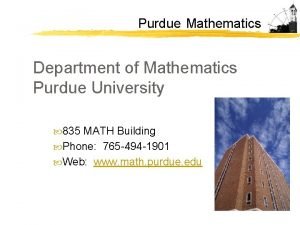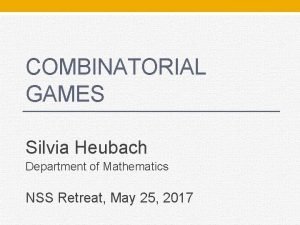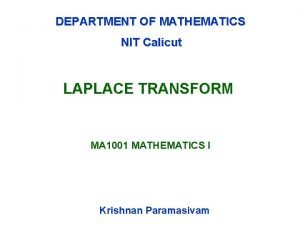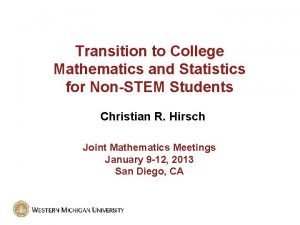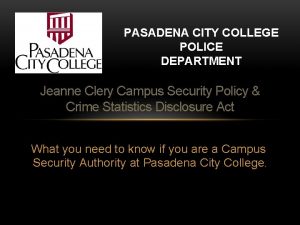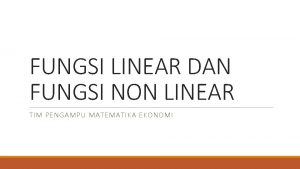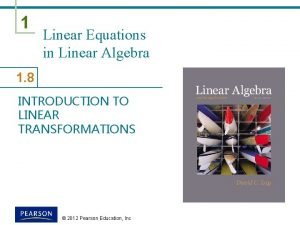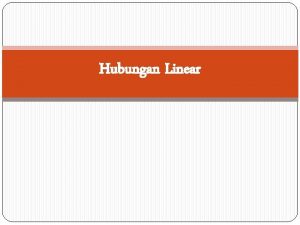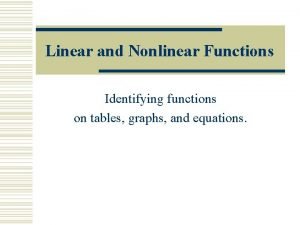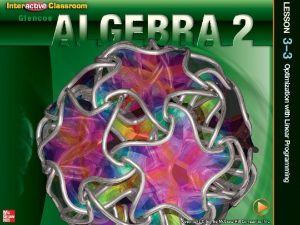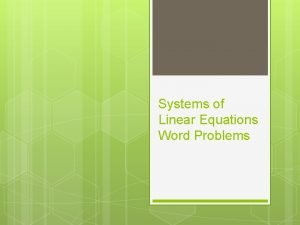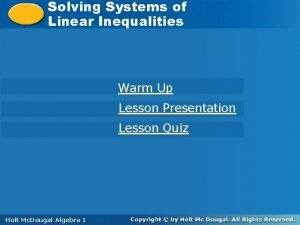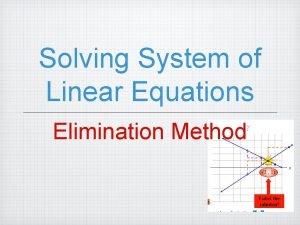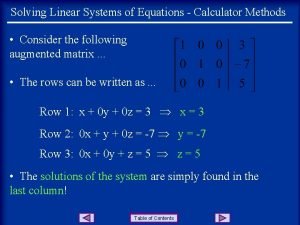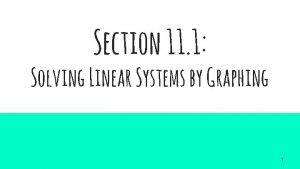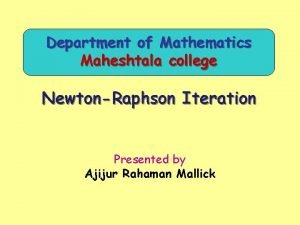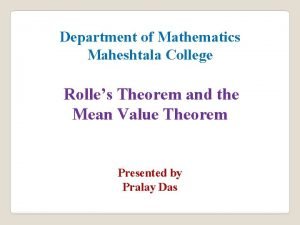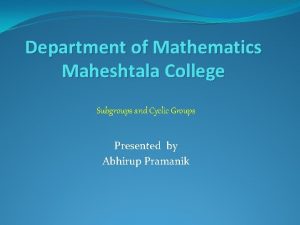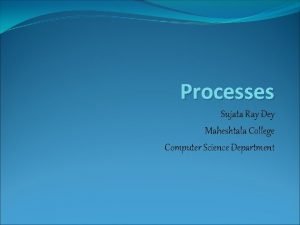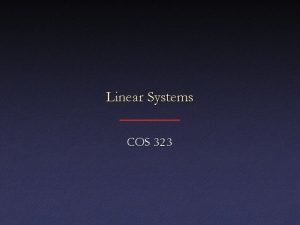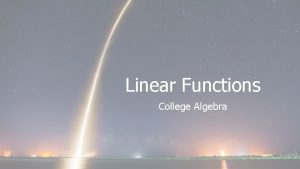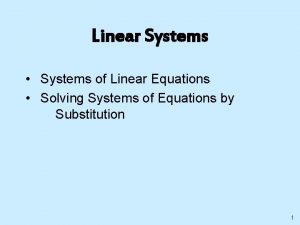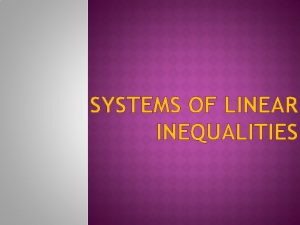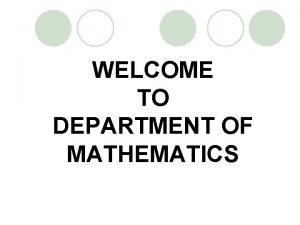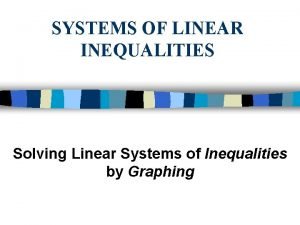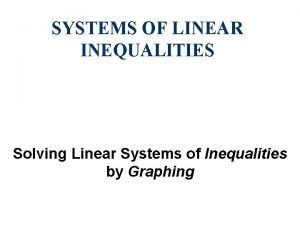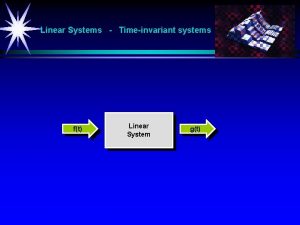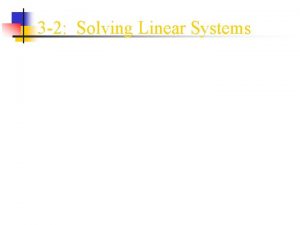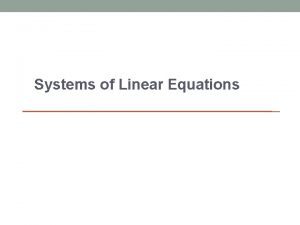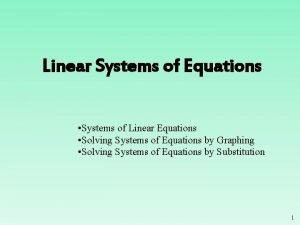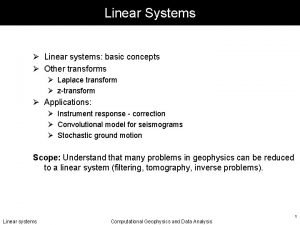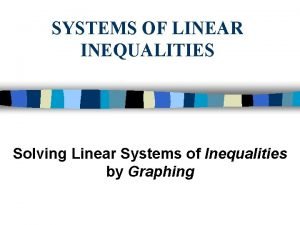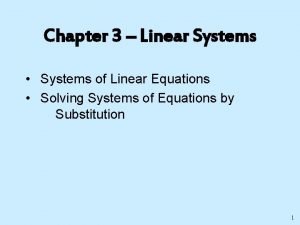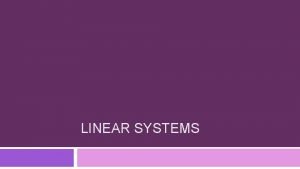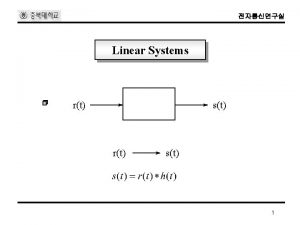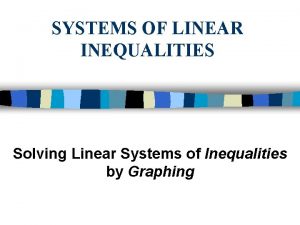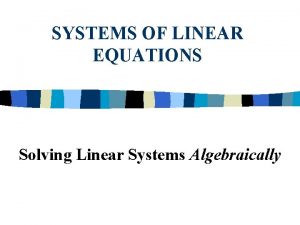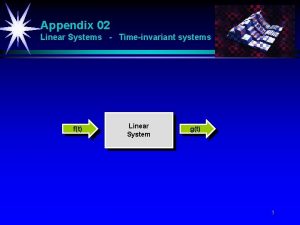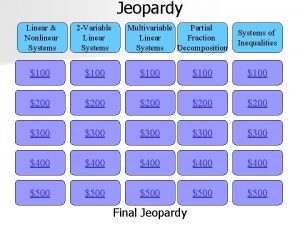DEPARTMENT OF MATHEMATICS Maheshtala College Systems of Linear





































- Slides: 37

DEPARTMENT OF MATHEMATICS Maheshtala College Systems of Linear Equations Presented by Ajijur Rahaman Mallick

Contents n n 1. 1 Introduction to Systems of Linear Equations 1. 2 Gaussian Elimination and Gauss-Jordan Elimination 2/39

1. 1 Introduction to Systems of Linear Equations n a linear equation in n variables: a 1, a 2, a 3, …, an, b: real number a 1: leading coefficient n Notes: x 1: leading variable (1) Linear equations have no products or roots of variables and no variables involved in trigonometric, exponential, or logarithmic functions. (2) Variables appear only to the first power. 3/39

n Ex 1: (Linear or Nonlinear) 4/39

n a solution of a linear equation in n variables: such that n Solution set: the set of all solutions of a linear equation 5/39

n Ex 2: (Parametric representation of a solution set) a solution: (2, 1), i. e. If you solve for x 1 in terms of x 2, you obtain By letting you can represent the solution set as And the solutions are or 6/39

n a system of m linear equations in n variables: n Consistent: A system of linear equations has at least one solution. n Inconsistent: A system of linear equations has no solution. 7/39

n Notes: Every system of linear equations has either (1) exactly one solution, (2) infinitely many solutions, or (3) no solution. 8/39

n Ex 4: (Solution of a system of linear equations) (1) (2) (3) 9/39

n Ex 5: (Using back substitution to solve a system in row echelon form) Sol: By substituting into (1), you obtain The system has exactly one solution: 10/39

n Ex 6: (Using back substitution to solve a system in row echelon form) Sol: Substitute and substitute into (2) and into (1) The system has exactly one solution: 11/39

n Equivalent: Two systems of linear equations are called equivalent if they have precisely the same solution set. n Notes: Each of the following operations on a system of linear equations produces an equivalent system. (1) Interchange two equations. (2) Multiply an equation by a nonzero constant. (3) Add a multiple of an equation to another equation. 12/39

n Ex 7: Solve a system of linear equations (consistent system) Sol: 13/39

So the solution is (only one solution) 14/39

n Ex 8: Solve a system of linear equations (inconsistent system) Sol: 15/39

So the system has no solution (an inconsistent system). 16/39

n Ex 9: Solve a system of linear equations (infinitely many solutions) Sol: 17/39

let then So this system has infinitely many solutions. 18/39

1. 2 Gaussian Elimination and Gauss-Jordan Elimination n n matrix: Notes: (1) Every entry aij in a matrix is a number. (2) A matrix with m rows and n columns is said to be of size m n. If (3) , then the matrix is called square of order n. (4) For a square matrix, the entries a 11, a 22, …, ann are called the main diagonal entries. 19/39

n Ex 1: n Note: Matrix Size One very common use of matrices is to represent a system of linear equations. 20/39

n a system of m equations in n variables: Matrix form: 21/39

n Augmented matrix: n Coefficient matrix: 22/39

n Elementary row operation: (1) Interchange two rows. (2) Multiply a row by a nonzero constant. (3) Add a multiple of a row to another row. n Row equivalent: Two matrices are said to be row equivalent if one can be obtained from the other by a finite sequence of elementary row operation. 23/39

n Ex 2: (Elementary row operation) 24/39

n Ex 3: Using elementary row operations to solve a system Linear System Associated Augemented Matrix Elementary Row Operation 25/39

Linear System Associated Augemented Matrix Elementary Row Operation 26/39

n Row-echelon form: (1, 2, 3) n Reduced row-echelon form: (1, 2, 3, 4) (1) All row consisting entirely of zeros occur at the bottom of the matrix. (2) For each row that does not consist entirely of zeros, the first nonzero entry is 1 (called a leading 1). (3) For two successive (nonzero) rows, the leading 1 in the higher row is farther to the left than the leading 1 in the lower row. (4) Every column that has a leading 1 has zeros in every position above and below its leading 1. 27/39

n Ex 4: (Row-echelon form or reduced row-echelon form) 28/39

n Gaussian elimination: The procedure for reducing a matrix to a row-echelon form. n Gauss-Jordan elimination: The procedure for reducing a matrix to a reduced row-echelon form. n Notes: (1) Every matrix has an unique reduced row echelon form. (2) A row-echelon form of a given matrix is not unique. (Different sequences of row operations can produce different row-echelon forms. ) 29/39

n Ex: (Procedure of Gaussian elimination and Gauss-Jordan elimination) Produce leading 1 The first nonzero column leading 1 Zeros elements below leading 1 Produce leading 1 The first nonzero Submatrix column 30/39

leading 1 Zeros elements below leading 1 Zeros elsewhere Submatrix Produce leading 1 31/39

n Ex 7: Solve a system by Gauss-Jordan elimination method (only one solution) Sol: 32/39

n Ex 8:Solve a system by Gauss-Jordan elimination method (infinitely many solutions) Sol: 33/39

Let So this system has infinitely many solutions. 34/39

n Homogeneous systems of linear equations: A system of linear equations is said to be homogeneous if all the constant terms are zero. 35/39

n n n Trivial solution: Nontrivial solution: other solutions Notes: (1) Every homogeneous system of linear equations is consistent. (2) If the homogenous system has fewer equations than variables, must have an system, infinite exactly number one of solutions. (3) then For aithomogeneous of the following is true. (a) The system has only the trivial solution. (b) The system has infinitely many nontrivial solutions in addition to the trivial solution. 36/39

n Ex 9: Solve the following homogeneous system Sol: Let 37/39
 Office of academics and transformation
Office of academics and transformation Department of mathematics purdue
Department of mathematics purdue Department of mathematics
Department of mathematics Nit calicut mathematics department
Nit calicut mathematics department Transition to college mathematics and statistics
Transition to college mathematics and statistics Rowan college of science and mathematics
Rowan college of science and mathematics Pasadena city college police department
Pasadena city college police department Asd college college readiness program
Asd college college readiness program Early college high school at midland college
Early college high school at midland college Simple linear regression and multiple linear regression
Simple linear regression and multiple linear regression Contoh soal metode biseksi
Contoh soal metode biseksi Linear and non linear text
Linear and non linear text Examples of linear plot
Examples of linear plot Contoh soal metode iterasi titik tetap
Contoh soal metode iterasi titik tetap Which pipeline is a linear
Which pipeline is a linear Multimedia definition
Multimedia definition Left-linear grammar
Left-linear grammar Fungsi linear dan non linear
Fungsi linear dan non linear Nonlinear function
Nonlinear function Linearly independent
Linearly independent Linear algebra linear transformation
Linear algebra linear transformation Cara penggal lereng
Cara penggal lereng Linear impulse equation
Linear impulse equation Contoh soal persamaan simultan
Contoh soal persamaan simultan Non linear tables
Non linear tables Linear or non linear
Linear or non linear Difference between linear and nonlinear equation
Difference between linear and nonlinear equation Linear and nonlinear editing
Linear and nonlinear editing Eliminasi gauss naif
Eliminasi gauss naif Closure properties of regular languages
Closure properties of regular languages Texto narrativo slide
Texto narrativo slide What authorizes entry into the emd phase
What authorizes entry into the emd phase Solving systems of linear inequalities by graphing
Solving systems of linear inequalities by graphing System of linear equations word problems
System of linear equations word problems 4-5 lesson quiz systems of linear inequalities
4-5 lesson quiz systems of linear inequalities Systems of equations
Systems of equations Solve system of linear equations calculator
Solve system of linear equations calculator 11-1 solving linear systems by graphing
11-1 solving linear systems by graphing

